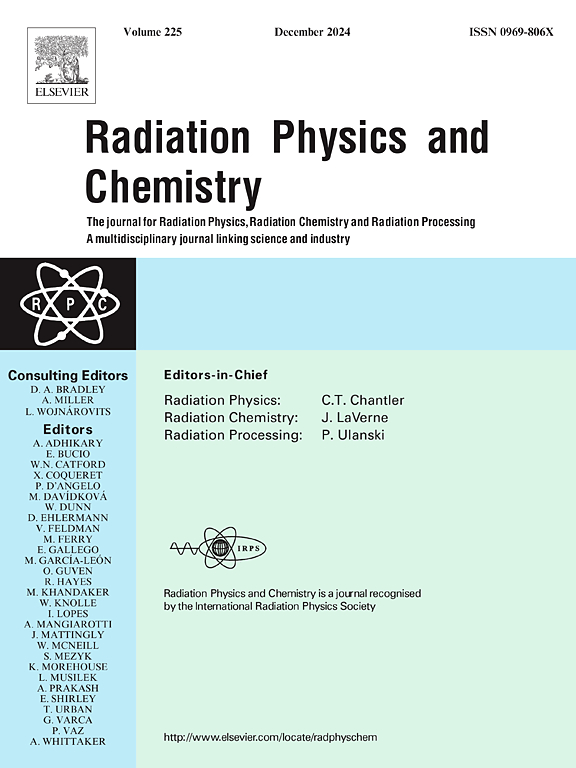A novel 3D polymer gel dosimeter based on polymethyl methacrylate gel (PMMAG) for radiotherapy: Ultrasonic evaluation
IF 2.8
3区 物理与天体物理
Q3 CHEMISTRY, PHYSICAL
引用次数: 0
Abstract
This study investigates the characteristics of a novel polymer gel dosimeter (PMMAG) for radiotherapy applications, focusing on its radiation absorption and sensitivity properties. The PMMAG dosimeters were evaluated using both UV–vis spectrophotometry and ultrasonic techniques. The results of the study, UV–vis analysis revealed a significant increase in dose response with the introduction of a cross-linker, peaking at a monomer-to-cross-linker ratio of 5:3. Sensitivity analysis indicated optimal sensitivity at this ratio, with values reaching 0.021 a.u./Gy. Ultrasound evaluation showed that the speed of sound and attenuation coefficient demonstrated a linear relationship and a strong positive correlation with an increase in the applied radiation dose, with the highest sensitivity observed at 8 Gy. The optimal sample exhibited the highest dose-response values at both 4 Gy and 8 Gy doses. Sensitivity values ranged from 2.1 to 2.75. The ultrasonic measurements demonstrated a significantly larger dynamic range in dose response curves compared to UV–vis dose-response data. It is concluded that ultrasound shows great potential as a technique for the evaluation of polymer gel dosimeters. The PMMAG can be introduced as a novel dosimeter for ionizing radiation dosimetry, validated through both optical and ultrasound assessment methods. The consistent and reliable performance of the PMMAG dosimeters makes them suitable for various applications in radiation therapy.
用于放射治疗的基于聚甲基丙烯酸甲酯凝胶 (PMMAG) 的新型 3D 聚合物凝胶剂量计:超声波评估
本研究调查了用于放射治疗的新型聚合物凝胶剂量计(PMMAG)的特性,重点是其辐射吸收和灵敏度特性。使用紫外可见分光光度法和超声波技术对 PMMAG 剂量计进行了评估。研究结果表明,紫外-可见光分析表明,随着交联剂的引入,剂量响应显著增加,在单体与交联剂的比例为 5:3 时达到峰值。灵敏度分析表明,该比例下的灵敏度最佳,达到 0.021 a.u./Gy。超声评估显示,声速和衰减系数呈线性关系,与应用辐射剂量的增加呈强烈的正相关,8 Gy 时的灵敏度最高。最佳样本在 4 Gy 和 8 Gy 剂量下的剂量反应值最高。灵敏度值从 2.1 到 2.75 不等。与紫外可见剂量反应数据相比,超声波测量显示剂量反应曲线的动态范围明显更大。结论是,超声波作为一种评估聚合物凝胶剂量计的技术显示出巨大的潜力。PMMAG 可作为一种新型剂量计用于电离辐射剂量测定,并通过光学和超声评估方法进行验证。PMMAG 剂量计稳定可靠的性能使其适用于放射治疗的各种应用。
本文章由计算机程序翻译,如有差异,请以英文原文为准。
求助全文
约1分钟内获得全文
求助全文
来源期刊

Radiation Physics and Chemistry
化学-核科学技术
CiteScore
5.60
自引率
17.20%
发文量
574
审稿时长
12 weeks
期刊介绍:
Radiation Physics and Chemistry is a multidisciplinary journal that provides a medium for publication of substantial and original papers, reviews, and short communications which focus on research and developments involving ionizing radiation in radiation physics, radiation chemistry and radiation processing.
The journal aims to publish papers with significance to an international audience, containing substantial novelty and scientific impact. The Editors reserve the rights to reject, with or without external review, papers that do not meet these criteria. This could include papers that are very similar to previous publications, only with changed target substrates, employed materials, analyzed sites and experimental methods, report results without presenting new insights and/or hypothesis testing, or do not focus on the radiation effects.
 求助内容:
求助内容: 应助结果提醒方式:
应助结果提醒方式:


